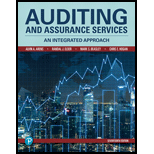
Auditing And Assurance Services
17th Edition
ISBN: 9780134897431
Author: ARENS, Alvin A.
Publisher: PEARSON
expand_more
expand_more
format_list_bulleted
Concept explainers
Question
Chapter 18, Problem 15DQP
To determine
Explain the differences between FOB destination and FOB origin. Explain the procedures that auditor must follow towards new acquisitions of the inventory on the FOB origin basis in the year end.
Expert Solution & Answer
Want to see the full answer?
Check out a sample textbook solution
Students have asked these similar questions
SUBJECT: FINANCIAL ACCOUNTING 2
Financial Accounting
Calculate the market value of the firm's stockholders equity on these financial accounting question
Chapter 18 Solutions
Auditing And Assurance Services
Ch. 18 - List five asset accounts, three liability...Ch. 18 - Prob. 2DQPCh. 18 - Prob. 3DQPCh. 18 - Prob. 4DQPCh. 18 - Prob. 5DQPCh. 18 - Prob. 6DQPCh. 18 - Prob. 7DQPCh. 18 - Prob. 8DQPCh. 18 - Prob. 9DQPCh. 18 - Prob. 10DQP
Ch. 18 - Prob. 11DQPCh. 18 - Prob. 13DQPCh. 18 - Prob. 14DQPCh. 18 - Prob. 15DQPCh. 18 - Prob. 16.1MCQCh. 18 - Prob. 16.2MCQCh. 18 - Prob. 16.3MCQCh. 18 - Prob. 17.1MCQCh. 18 - Prob. 17.2MCQCh. 18 - Prob. 17.3MCQCh. 18 - Prob. 18.1MCQCh. 18 - Prob. 18.2MCQCh. 18 - Prob. 18.3MCQCh. 18 - Prob. 19DQPCh. 18 - Prob. 20DQPCh. 18 - Prob. 21DQPCh. 18 - Prob. 22DQPCh. 18 - The following misstatements are included in the...Ch. 18 - Prob. 24DQPCh. 18 - Prob. 25DQPCh. 18 - Prob. 26DQPCh. 18 - Prob. 27DQPCh. 18 - Prob. 28DQPCh. 18 - Prob. 30C
Knowledge Booster
Learn more about
Need a deep-dive on the concept behind this application? Look no further. Learn more about this topic, accounting and related others by exploring similar questions and additional content below.Similar questions
- Problem related general Accountingarrow_forwardFinancial accountingarrow_forwardSuppose you received a total of $1,245 in dividends plus $16,430 in proceeds from selling 520 shares of Tesla Inc. that you had bought at $28.75 a share. What is your capital gains yield on this stock? Answer this financial accounting problem. a. 14.92% b. 9.90% c. 16.54% d. -2.43% e. 7.65%arrow_forward
- ????arrow_forwardABC Ltd. reported a net income of $850 million and sales revenue of $18,200 million in 2023. The company's total assets were $7,800 million at the beginning of the year and $8,600 million at the end of the year. a) Compute the asset turnover ratio. b) Compute the profit margin ratio.arrow_forwardVariable expenses:220500, fixed expenses:72000arrow_forward
arrow_back_ios
SEE MORE QUESTIONS
arrow_forward_ios
Recommended textbooks for you
 Auditing: A Risk Based-Approach (MindTap Course L...AccountingISBN:9781337619455Author:Karla M Johnstone, Audrey A. Gramling, Larry E. RittenbergPublisher:Cengage LearningPrinciples of Accounting Volume 1AccountingISBN:9781947172685Author:OpenStaxPublisher:OpenStax College
Auditing: A Risk Based-Approach (MindTap Course L...AccountingISBN:9781337619455Author:Karla M Johnstone, Audrey A. Gramling, Larry E. RittenbergPublisher:Cengage LearningPrinciples of Accounting Volume 1AccountingISBN:9781947172685Author:OpenStaxPublisher:OpenStax College

Auditing: A Risk Based-Approach (MindTap Course L...
Accounting
ISBN:9781337619455
Author:Karla M Johnstone, Audrey A. Gramling, Larry E. Rittenberg
Publisher:Cengage Learning


Principles of Accounting Volume 1
Accounting
ISBN:9781947172685
Author:OpenStax
Publisher:OpenStax College